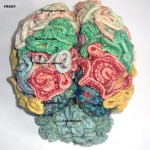If you follow just one guideline, follow just this one: Less is More!
- Keep it simple
- Remove extraneous detail
- Pare the learning down to essential components
- Clearly explain how these components relate to one another
- Help learners focus on what’s important.
The capacity for the brain to hold new information is limited.
- By the capacity of working memory (sometimes called short-term memory)
- By the how complex the material is to the learner
So, when learning try to communicate new knowledge:
- no more then 2-4 elements at a given time (i.e. per slide)

Knitted Brain
Some background information and research in case you want to know:
- When introducing new knowledge, the constraints of working memory limit how much information can be processed in a given time frame. Miller, 1950’s discovered the rule of 7 — no more than 7 items could be kept active in short term memory.
- However, when you’re trying to understand something, relate components of an concept, compare and contrast, then you want no more than 2-4 elements in working memory. (Sweller’s cognitive load theory).
- Interference can limit recall of information. Recall is worse the more facts you learn about a concept. Interference literally knocks the old information out of your brain when attaching new facts to a concept, if the facts have no intrinsic relationship to each other. It interferes when the memory one is trying to create. This is why extraneous information is often not advised. (Anderson, 2006).
- Fan effects – the more facts or links associated with a concept, the longer it will take to recall any one fact.
- Redundancy effects, as opposed to interference, can help with recall. Especially when the pieces are linked appropriately.
-
- Example of irrelevant facts that INTERFERE:
- Locke was unhappy as a student at Westminster.
- Locke felt fruits were unwholesome for children.
- Example 2 of REDUNDANT facts that help in recall.
- Mozart made a long journey from Munich to Paris.
- Mozart was intrigued by musical developments coming out of Paris.
- Example of irrelevant facts that INTERFERE:
- People use redundant facts to infer the target concept.
For more information, read up on Sweller’s cognitive load theory, and Mayer’s theory of Multimedia Learning.

0 Responses
Stay in touch with the conversation, subscribe to the RSS feed for comments on this post.